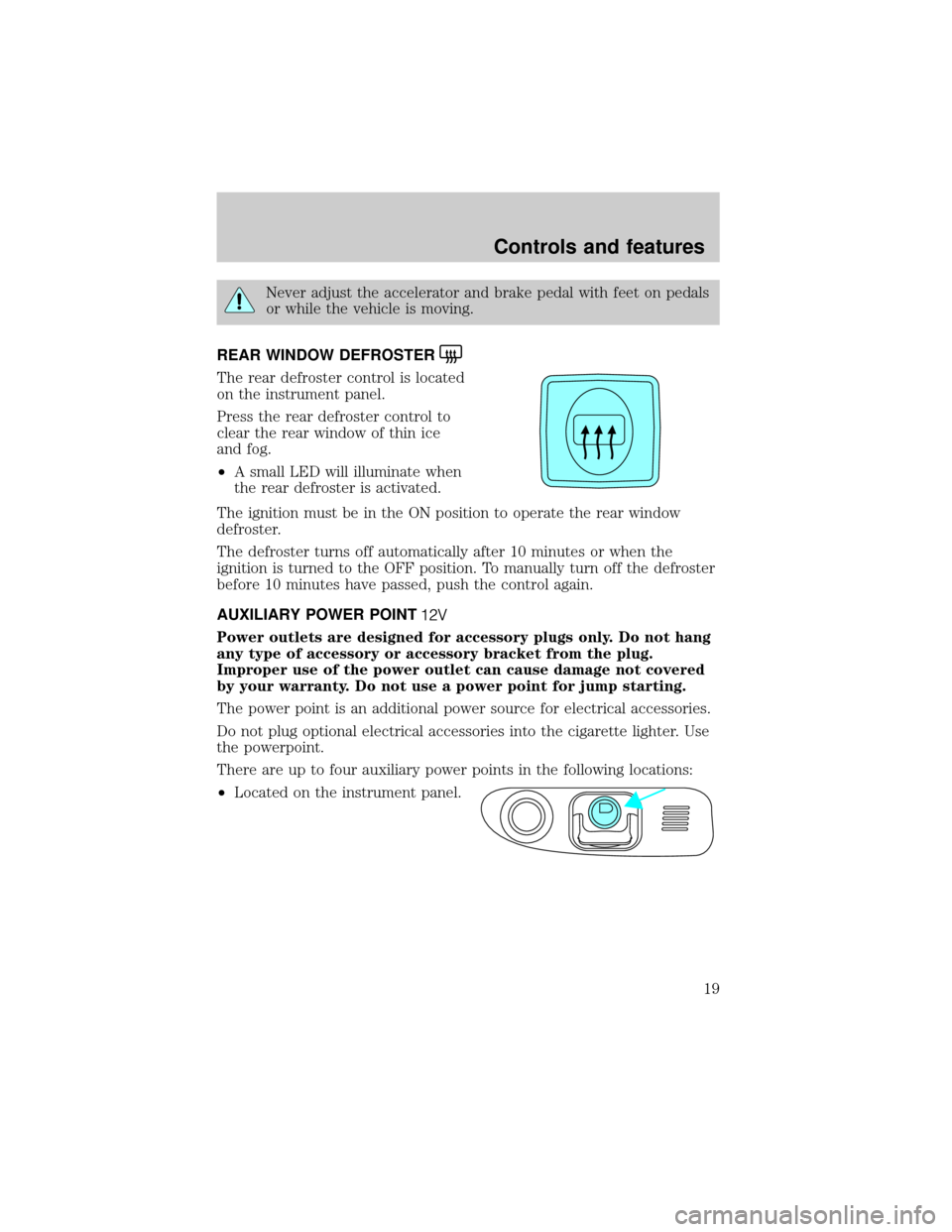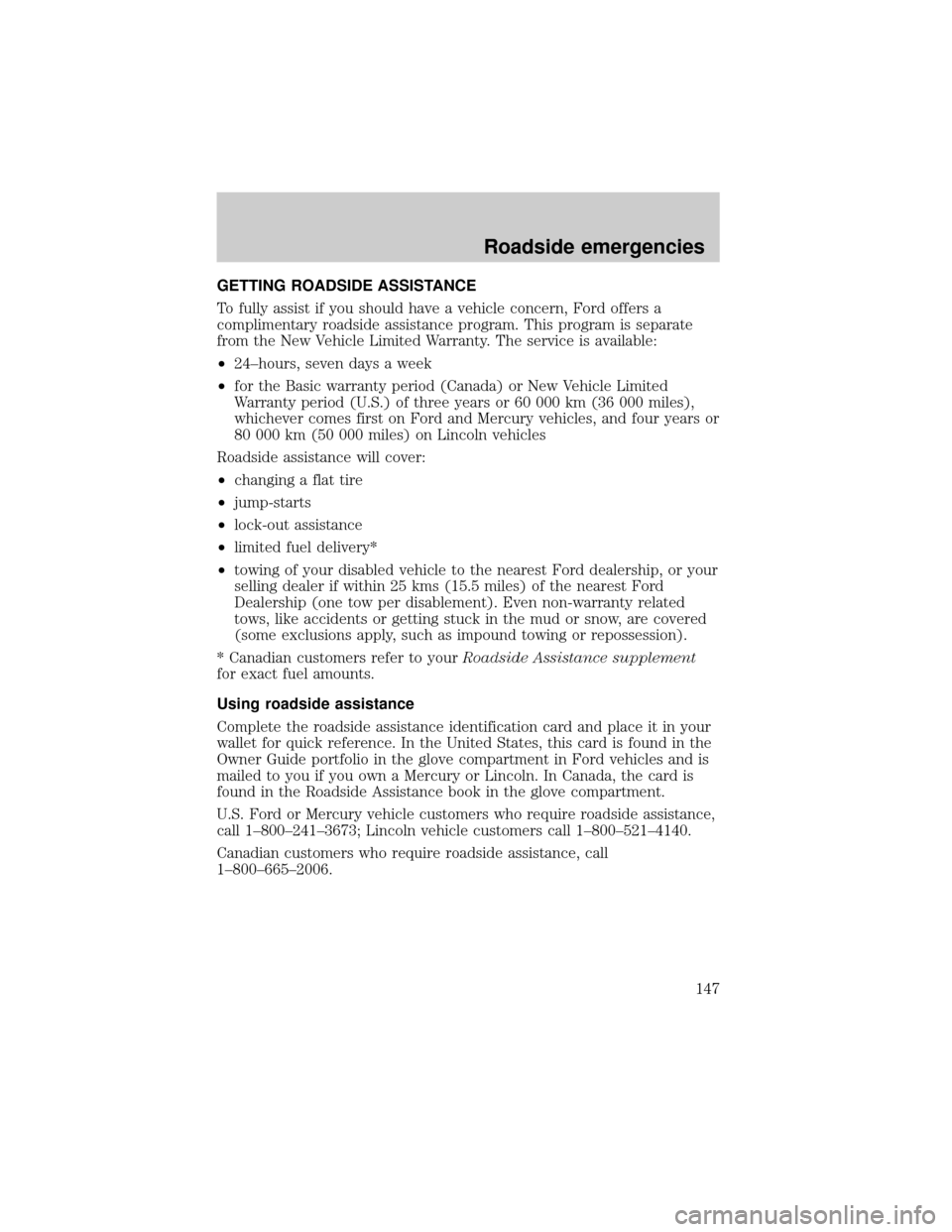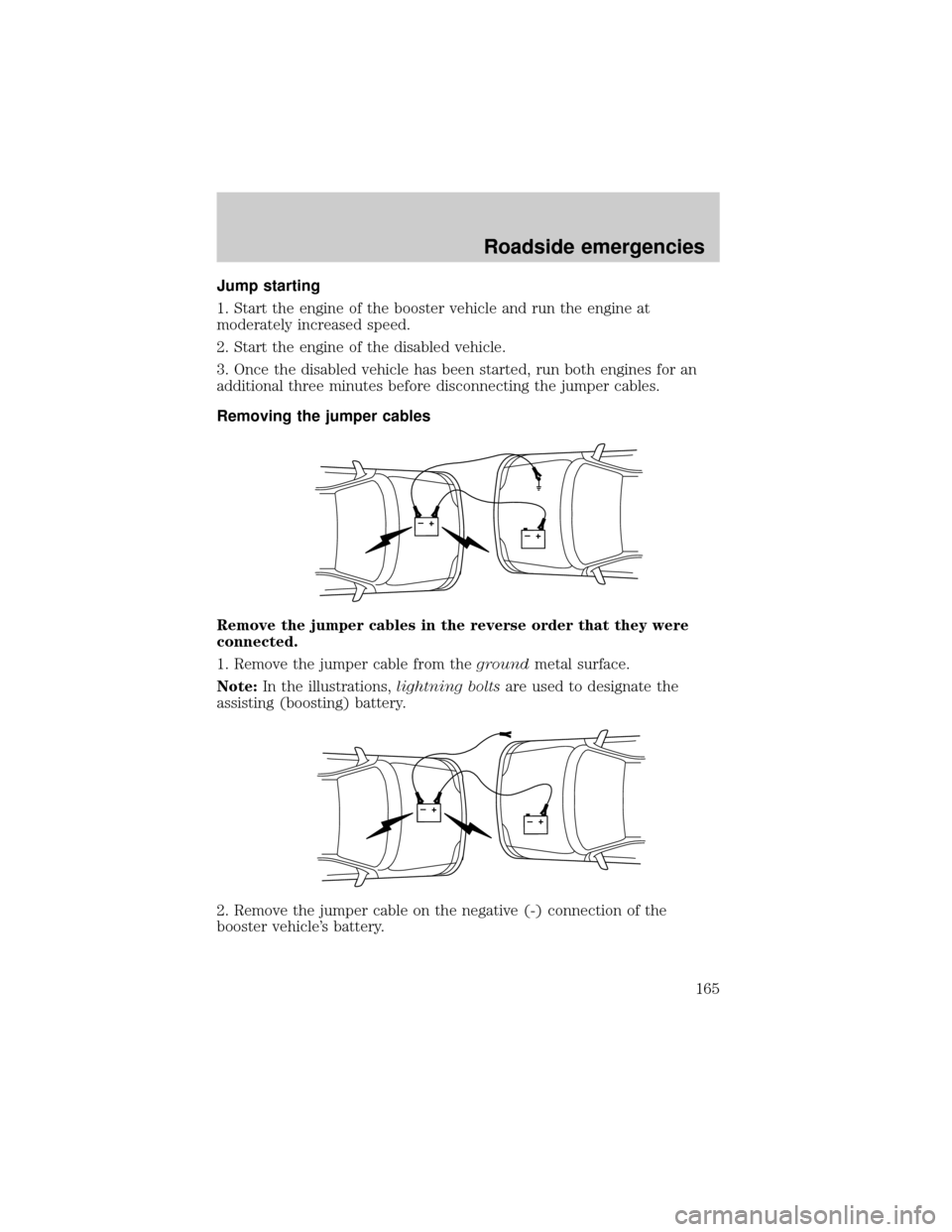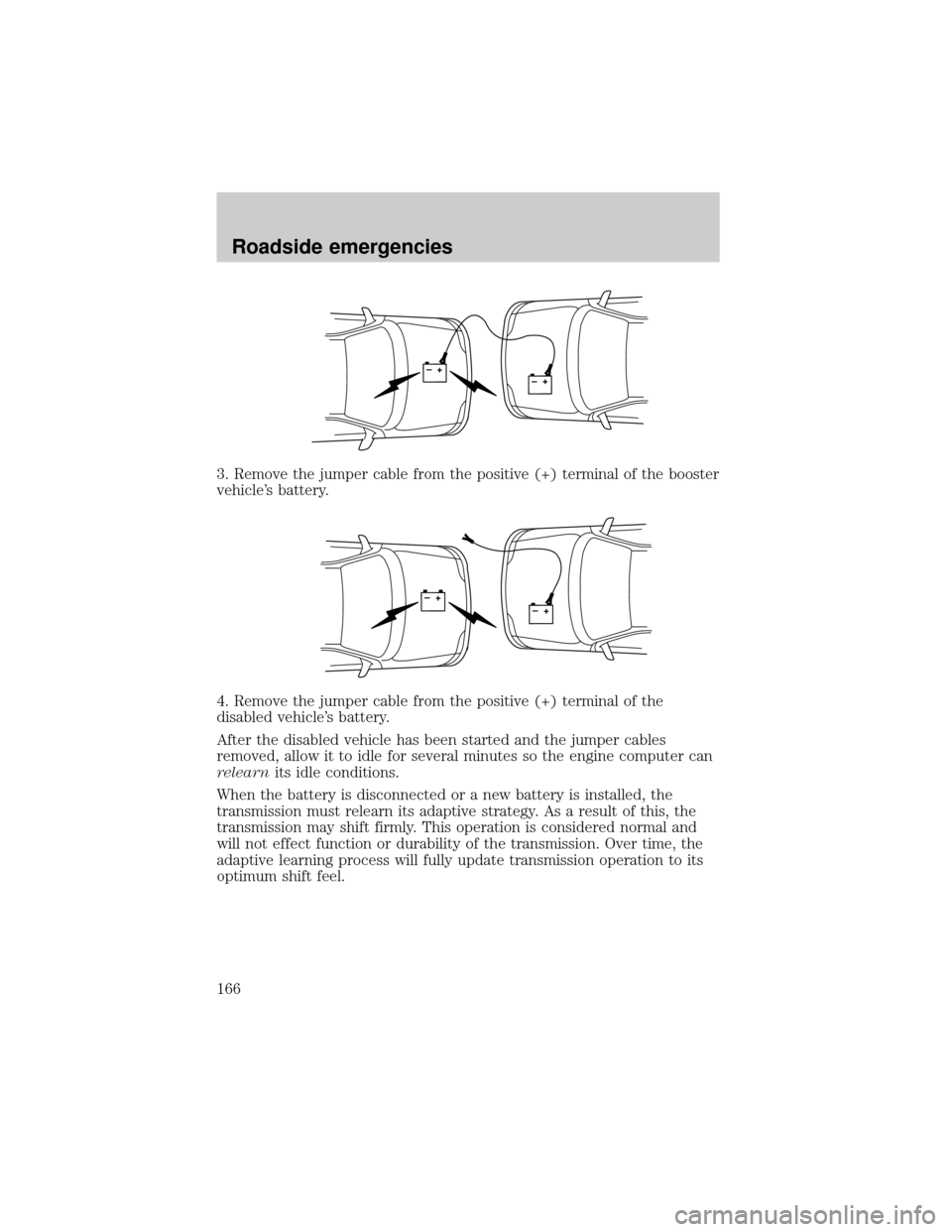2002 LINCOLN BLACKWOOD jump start
[x] Cancel search: jump startPage 19 of 248

Never adjust the accelerator and brake pedal with feet on pedals
or while the vehicle is moving.
REAR WINDOW DEFROSTER
The rear defroster control is located
on the instrument panel.
Press the rear defroster control to
clear the rear window of thin ice
and fog.
²A small LED will illuminate when
the rear defroster is activated.
The ignition must be in the ON position to operate the rear window
defroster.
The defroster turns off automatically after 10 minutes or when the
ignition is turned to the OFF position. To manually turn off the defroster
before 10 minutes have passed, push the control again.
AUXILIARY POWER POINT
Power outlets are designed for accessory plugs only. Do not hang
any type of accessory or accessory bracket from the plug.
Improper use of the power outlet can cause damage not covered
by your warranty. Do not use a power point for jump starting.
The power point is an additional power source for electrical accessories.
Do not plug optional electrical accessories into the cigarette lighter. Use
the powerpoint.
There are up to four auxiliary power points in the following locations:
²Located on the instrument panel.
Controls and features
19
Page 147 of 248

GETTING ROADSIDE ASSISTANCE
To fully assist if you should have a vehicle concern, Ford offers a
complimentary roadside assistance program. This program is separate
from the New Vehicle Limited Warranty. The service is available:
²24±hours, seven days a week
²for the Basic warranty period (Canada) or New Vehicle Limited
Warranty period (U.S.) of three years or 60 000 km (36 000 miles),
whichever comes first on Ford and Mercury vehicles, and four years or
80 000 km (50 000 miles) on Lincoln vehicles
Roadside assistance will cover:
²changing a flat tire
²jump-starts
²lock-out assistance
²limited fuel delivery*
²towing of your disabled vehicle to the nearest Ford dealership, or your
selling dealer if within 25 kms (15.5 miles) of the nearest Ford
Dealership (one tow per disablement). Even non-warranty related
tows, like accidents or getting stuck in the mud or snow, are covered
(some exclusions apply, such as impound towing or repossession).
* Canadian customers refer to yourRoadside Assistance supplement
for exact fuel amounts.
Using roadside assistance
Complete the roadside assistance identification card and place it in your
wallet for quick reference. In the United States, this card is found in the
Owner Guide portfolio in the glove compartment in Ford vehicles and is
mailed to you if you own a Mercury or Lincoln. In Canada, the card is
found in the Roadside Assistance book in the glove compartment.
U.S. Ford or Mercury vehicle customers who require roadside assistance,
call 1±800±241±3673; Lincoln vehicle customers call 1±800±521±4140.
Canadian customers who require roadside assistance, call
1±800±665±2006.
Roadside emergencies
147
Page 162 of 248

12. Remove the jack and fully
tighten the lug nuts in the order
shown.
13. Stow the flat tire. Refer to
Stowing the spare tire.
14. Stow the jack and lug wrench.
Make sure the jack is fastened so it
does not rattle when you drive.
15. Unblock the wheels.
16. Turn on the air suspension switch.
JUMP STARTING YOUR VEHICLE
The gases around the battery can explode if exposed to flames,
sparks, or lit cigarettes. An explosion could result in injury or
vehicle damage.
Batteries contain sulfuric acid which can burn skin, eyes, and
clothing, if contacted.
Do not attempt to push-start your vehicle. Automatic
transmissions do not have push-start capability; also, the
catalytic conveter may become damaged..
Preparing your vehicle
When the battery is disconnected or a new battery is installed, the
transmission must relearn its adaptive strategy. As a result of this, the
transmission may shift firmly. This operation is considered normal and
will not affect function or durability of the transmission. Over time, the
adaptive learning process will fully update transmission operation to its
optimum shift feel.
1.Use only a 12±volt supply to start your vehicle.
2. Do not disconnect the battery of the disabled vehicle as this could
damage the vehicle's electrical system.
3. Park the booster vehicle close to the hood of the disabled vehicle
making sure the two vehiclesdo nottouch. Set the parking brake on
both vehicles and stay clear of the engine cooling fan and other moving
parts.
1
4 3
2 5
Roadside emergencies
162
Page 165 of 248

Jump starting
1. Start the engine of the booster vehicle and run the engine at
moderately increased speed.
2. Start the engine of the disabled vehicle.
3. Once the disabled vehicle has been started, run both engines for an
additional three minutes before disconnecting the jumper cables.
Removing the jumper cables
Remove the jumper cables in the reverse order that they were
connected.
1. Remove the jumper cable from thegroundmetal surface.
Note:In the illustrations,lightning boltsare used to designate the
assisting (boosting) battery.
2. Remove the jumper cable on the negative (-) connection of the
booster vehicle's battery.
+–+–
+–+–
Roadside emergencies
165
Page 166 of 248

3. Remove the jumper cable from the positive (+) terminal of the booster
vehicle's battery.
4. Remove the jumper cable from the positive (+) terminal of the
disabled vehicle's battery.
After the disabled vehicle has been started and the jumper cables
removed, allow it to idle for several minutes so the engine computer can
relearnits idle conditions.
When the battery is disconnected or a new battery is installed, the
transmission must relearn its adaptive strategy. As a result of this, the
transmission may shift firmly. This operation is considered normal and
will not effect function or durability of the transmission. Over time, the
adaptive learning process will fully update transmission operation to its
optimum shift feel.
+–+–
+–+–
Roadside emergencies
166
Page 239 of 248

in rear seat ..............................119
Cleaning your vehicle ...............212
exterior ....................................212
instrument cluster lens ..........216
instrument panel ....................216
interior .....................................216
plastic parts ....................214±215
safety belts ..............................217
washing ....................................212
waxing .....................................212
wheels ......................................213
windows ..................................216
wiper blades ............................215
woodtone trim ........................216
Climate control (see Air
conditioning or Heating) ............41
Clock ............................................21
Compass, electronic
calibration .................................61
set zone adjustment .................60
Console
overhead ....................................57
Controls
power seat .................................90
steering column ........................55
Coolant
checking and adding ..............175
refill capacities ................179, 218
specifications ..................220, 222
Cruise control
(see Speed control) ....................50
Customer Assistance ................147
Ford accessories for your
vehicle .....................................232
Ford Extended Service
Plan ..........................................225
Getting assistance outside
the U.S. and Canada ..............231Getting roadside assistance ...147
Getting the service
you need .................................225
Ordering additional owner's
literature .................................236
The Dispute Settlement
Board .......................................228
Utilizing the
Mediation/Arbitration
Program ...................................231
D
Defrost
rear window ..............................19
Dipstick
automatic transmission
fluid ..........................................183
engine oil .................................171
Doors
door ajar warning .....................11
lubricant specifications ..........220
Driveline universal joint and
slip yoke ....................................185
Driving under special
conditions
through water .........................146
E
Emergencies, roadside
jump-starting ..........................162
Emission control system ..........202
Engine ........................................222
check engine/service engine
soon light ....................................8
coolant .....................................175
fail-safe coolant ......................180
idle speed control ...................185
Index
239
Page 241 of 248

Headlamps ...................................17
aiming ..............................210±211
autolamp system .......................18
bulb specifications ..................209
flash to pass ..............................17
high beam ...........................10, 17
replacing bulbs .......................204
turning on and off ....................17
warning chime ..........................13
Heating ........................................41
HomeLink universal
transceiver (see Garage
door opener) .........................65±68
Hood ..........................................169
I
Ignition .................................49, 222
Infant seats
(see Safety seats) .....................118
Inspection/maintenance (I/M)
testing ........................................203
Instrument panel
cleaning ...................................216
cluster ..................................8, 216
lighting up panel
and interior ...............................18
location of components ..............8
J
Jack ............................................157
positioning ...............................157
storage .....................................157
Jump-starting your vehicle ......162K
Keyless entry system
autolock .....................................85
locking and
unlocking doors ..................88±89
programming entry code .........88
Keys .................................49, 77±79
key in ignition chime ...............12
positions of the ignition ...........49
valet key ....................................49
L
Lamps
autolamp system .......................18
bulb replacement
specifications chart ................209
cargo lamps ...............................18
fog lamps ...................................17
headlamps .................................17
headlamps, flash to pass ..........17
instrument panel, dimming .....18
interior lamps .............63±64, 208
replacing bulbs .......204, 206±208
Lane change indicator
(see Turn signal) ........................49
Liftgate ........................................73
Lights, warning and indicator ......8
air bag ..........................................9
air suspension .........................133
anti-lock brakes (ABS) ....10, 129
anti-theft ...................................10
brake ..........................................10
charging system ........................11
check coolant ............................11
door ajar ....................................11
engine oil pressure ...................11
high beam .................................10
low fuel ........................................8
Index
241
Page 243 of 248

S
Safety belts (see Safety
restraints) ....................12, 100±105
Safety defects, reporting ..........237
Safety restraints ................100±105
belt minder .............................107
cleaning the safety
belts .................................110, 217
extension assembly ................106
for adults .........................101±104
for children .....................116±117
warning light and
chime .............................9, 12, 106
Safety seats for children ..........118
Seat belts (see Safety
restraints) ..................................100
Seats
child safety seats ....................118
climate control ..........................93
memory seat .......................86, 92
SecuriLock passive anti-theft
system ....................................77±79
Servicing your vehicle ..............168
Snowplowing .................................3
Spark plugs,
specifications .....................218, 222
Special notice ................................3
ambulance conversions ..............3
utility-type vehicles ....................3
Specification chart,
lubricants ...........................220, 222
Speed control ..............................50
Speedometer ...............................14
Starting your vehicle ........125, 127
jump starting ..........................162Steering wheel
controls ......................................55
tilting .........................................56
T
Tachometer .................................15
Tires ...........................157, 190±191
changing ..........................157±158
checking the pressure ............191
replacing ..................................193
rotating ....................................192
snow tires and chains ............193
tire grades ...............................191
treadwear ................................190
Tonneau cover .................63, 74, 89
Towing .......................................141
recreational towing .................145
trailer towing ..........................141
wrecker ....................................167
Traction control ........................133
active light ................................12
Transmission .............................135
fluid, checking and adding
(automatic) .............................183
fluid, refill capacities ..............218
lubricant specifications ..220, 222
Transmission control indicator
light ..............................................11
Trip odometer .............................15
Trunk .....................................74, 76
Turn signal ............................10, 49
V
Vehicle dimensions ...................222
Vehicle Identification Number
(VIN) ..........................................224
Index
243